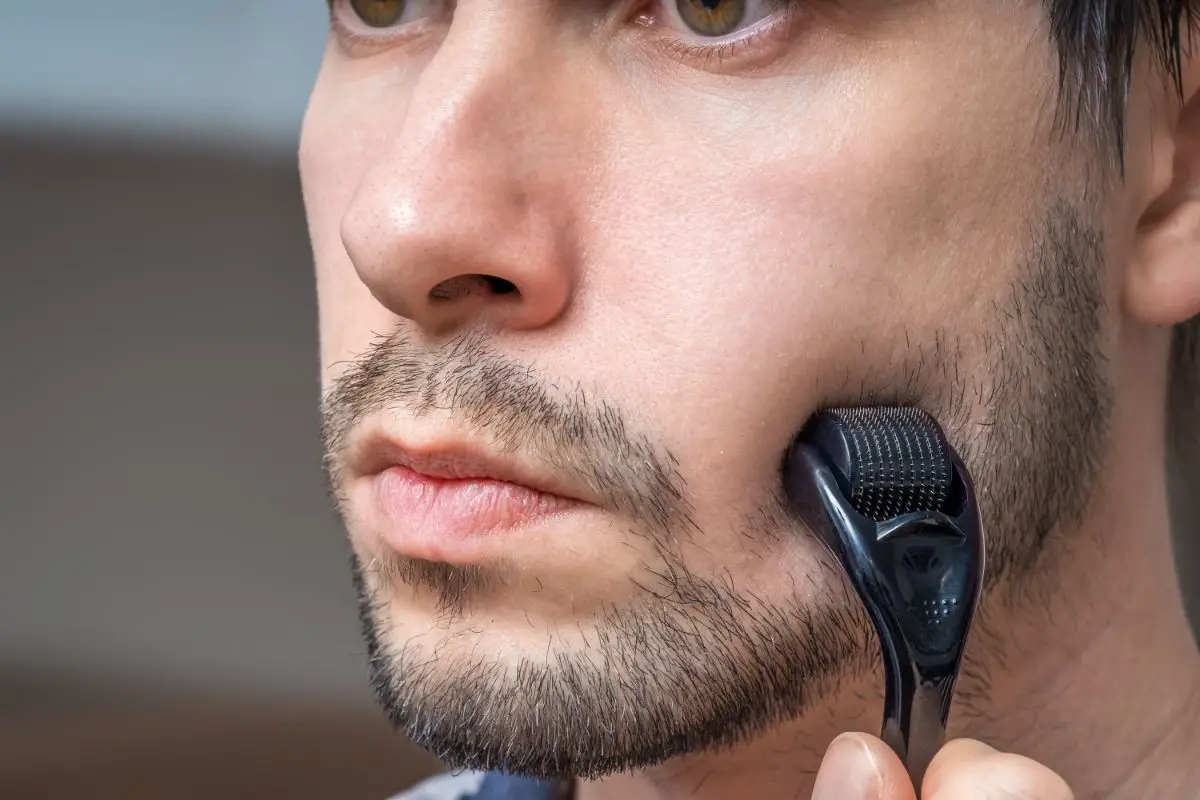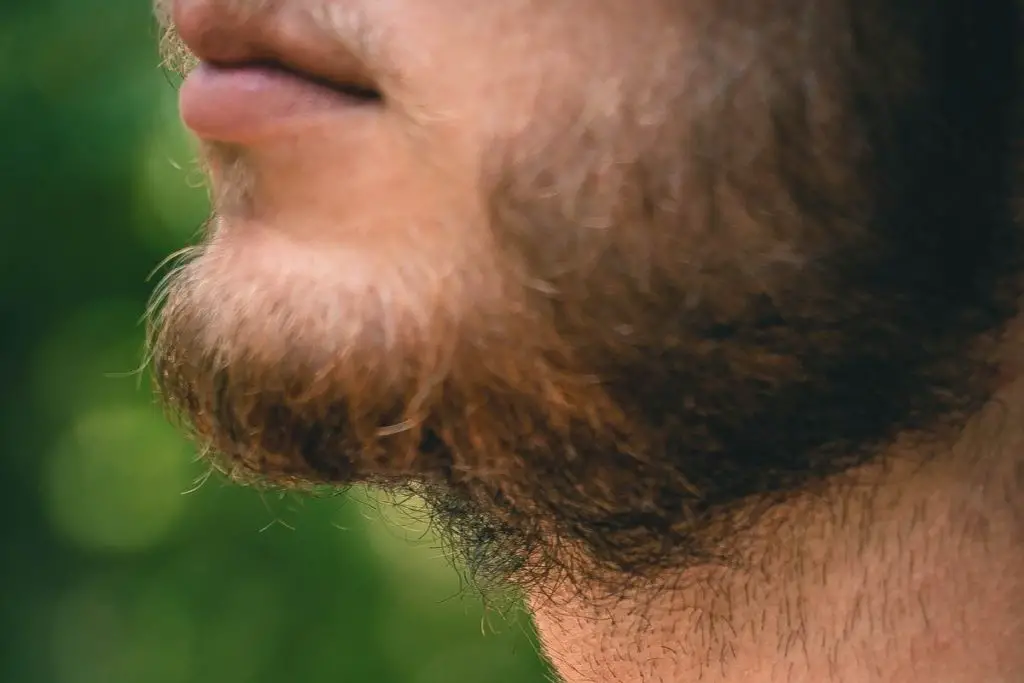Beard oils are hair care products designed to be used on facial hair. They are applied to the hair and the underlying skin to improve the beard’s appearance.
These products contain a mix of carrier base oils and essential oils that are seen in many everyday products. Beard oils may seem safe, but you should still use them with caution.

Beard oils can cause many side effects. Some of these affect how your hair looks, while others can raise safety concerns.
These side effects are rare, as many companies create safe formulations that are tested before they go on sale. However, you should still be aware of the potential risks that come with using beard oils.
We’ll cover some of these side effects in more detail below. You’ll also find other disadvantages of beard oil that aren’t as serious, but regardless, you should still be aware of them
Side Effects From Using Beard Oil
Irritation And Allergic Reactions
Many beard oils are made with natural substances, but even so, this doesn’t prevent you from having an allergic reaction.
Beard oil formulations vary with each brand. Carrier and essential oil are available in hundreds of different varieties, so there’s always a chance of being allergic to one of them.
Allergic reactions to beard oil normally occur due to nut oils being used. They can also happen as a result of potent essential oils used for added scent.
To avoid this happening, test out your beard oil beforehand. Apply a small amount onto your face and see if you notice anything abnormal, like swelling, hives, and redness.
Keep on the lookout for chest tightness, feeling out of breath, or general illness.
May Inhibit Beard Growth
Beard oils may be designed to improve how your beard looks, but some of these products may suppress facial hair growth.
Ingredients within the oils may affect your testosterone and DHT levels. These hormones are important, as they grow and maintain your beard hair.
Oils are bad for these hormones including plant, seed, and polyunsaturated vegetable oils. The chance of this increases if these oils aren’t stabilized with saturated and monounsaturated oils.
The worst oils for facial hair growth are rice bran, pumpkin seed, and safflower oil. You should also avoid tea tree, eucalyptus, and lavender essential oils.
Any substance that has a large amount of unstable polyunsaturated fats can affect your DHT levels. Some of these oils include hemp seed, canola, sunflower, and sesame seed oil.
If one of these oils is in your beard oil product, you don’t need to worry too much.
If your product contains a lot of the oils mentioned here, it should be avoided at all costs, especially if you’re trying to grow your beard.
Formulas May Cause Skin Issues
Beard oil has the added benefit of moisturizing your skin, thanks to the oils, but a low-quality formula may be making your skin dry instead.
Polyunsaturated fats oxidize easily on contact with heat, oxygen, and light. Your face also emits these three features. Beard oils that contain a lot of polyunsaturated fats need to be balanced with less reactive oils.
If your product isn’t neutralized and still contains a lot of polyunsaturated fats, it will react when applied to your face. When this happens, the oils can turn rotten and stale on your beard and skin.
As this occurs, the oils become solid and begin drying out the skin beneath your facial hair. This causes irritation and itchiness, which results in dandruff in your beard.
To avoid this, make sure your beard oil uses a low amount of polyunsaturated fats, or even better, none at all.
You should also check that the formula contains vitamin E to neutralize lipids. Vitamin E also stops essential oils from turning rotten.
If your well-liked beard oil doesn’t contain any vitamin E, you can purchase a bottle and add a few drops to your product.
Can Decrease Sunlight Tolerance
Essential oils may smell nice, but some of these can affect your skin’s sensitivity to sunlight. If your skin’s photosensitivity grows, your skin absorbs more UV rays which increase the chance of sun damage.
This may not be a huge issue if you live in a grayer climate. However, if you use tanning beds, work outside, or live in a sunnier area, you need to be careful.
Make sure that your product doesn’t contain any essential oils that affect your skin.
These oils include grapefruit, bergamot, angelica, and citrus oils (orange, lemon, lime). Be mindful of phototoxic reaction symptoms, like rashes, burning, spots, and itching.
Safety Concerns For Pets & Children
Essential oils are safe for most adults, but not for those who are more sensitive, like children and pets. Essential oils are only used in tiny drops, but this amount is still enough to cause harm.
This is because these substances are very potent. To give you a better picture of this, it takes over 250 pounds to make one pound of peppermint essential oil.
It also takes over 1000 pounds of roses to make a pound of rose oil. Essential oils are often diluted with carrier oils so they can be used safely.
However, when these oils aren’t made weaker, they can be extremely toxic to pets. They can also be very dangerous for humans if they are consumed.
Essential oils may be sourced from natural ingredients, but they are extremely strong and reactive, so always use them with caution.
A lot of beard oils contain lavender and tea tree oil, but it’s best to avoid these, especially if you have small children or pets.
Other Disadvantages Of Beard Oil

The side effects above point out why some beard oils are harmful, and in some cases, toxic. However, even if your beard oil formula is safe to use, it may come with some disadvantages. We’ll list a few less serious drawbacks of beard oils below.
Can Cost A Lot
Beard oils can be expensive, which is surprising for the amount of product that you get. Decent 30ml beard oils can cost anywhere from $20 to $30.
If you use your product regularly, the cost of these can add up over time. It’s easy to go through a bottle of beard oil every month, although people with longer beards may use a bottle up sooner.
If you need beard oil in your routine, you don’t have to give it up completely! With a little research, you can find several less expensive beard oils that work just as well as ones costing more money.
You can also try making your own beard oil with recipes found online. Just be sure to follow the above advice and avoid any oils that could cause side effects.
May Make Facial Hair Shiny
Some beard oils are lightweight, but others have a heavier consistency. Thicker beard oils can moisturize the skin and condition your beard well, but they may also weigh your facial hair down.
Heavy beard oils can be too greasy for some people. If you can relate, you may prefer using a lighter blend, or trying a beard moisturizer instead of oil.
However, keep in mind that lightweight beard oils tend to be more expensive due to the specialized formula.
Not all beard oils are the same, but you should still be aware of this risk while looking for a product.
If you’re stuck with heavy beard oil, you can opt for using it as a deep conditioner at night. This will nourish your facial hair as you sleep, but you can wash out any residue in the morning.
Product Lacks Hold
Lots of beard care products can add extra hold to your facial hair, but beard oils don’t normally do this.
These products are better for softening and neatening up beard hairs. Nevertheless, if your beard isn’t cut and styled properly, you can’t just rely on beard oil to neaten up its appearance.
Unruly beards will need styling balms, heated combs, and specific care techniques. Beard oils will only make the hairs look shiny and keep the hairs soft.
If you don’t like the look of a shiny beard, swap your beard oil for a matte wax or styling balm. These products will allow you to manipulate and style your facial hair in the way you choose.
Safer Beard Oil Ingredients
Some beard oils are safer to use, as they contain less irritating ingredients. The best beard oil ingredients to look out for are meadowfoam seed and jojoba oil.
These have the lowest chance of protruding side effects. Any beard oil recipes that aim to be anti-photosensitive, anti-allergenic, and hormone safe should use these oils as the main base.
Another safer beard oil substance is vitamin E sourced from wheat germ. Vitamin E is an antioxidant and is also fat-soluble.
It will stop reactive polyunsaturated essential and carrier oils from oxidizing, making the product better for your skin and beard.
Making your beard oil is another way to ensure your product is safe. A simple recipe involves using half an ounce of meadowfoam seed oil, half an ounce of jojoba oil, and 5 drops of vitamin E oil.
Simply mix the oils and pour them into a dark glass bottle. Bottles with dropper caps will make applying the oil easier.
Conclusion
Beard oils can be fantastic products, but they may not be suitable for everyone. People who have allergy risks, are exposed to sun rays, and have children or pets should be wary of beard oils.
Always look at the formula to make sure it’s free from any irritating or toxic ingredients. Beard oils can also affect how your facial looks.
If you like a shinier beard, this may not be an issue, but those that prefer to style theirs should look for another product. No matter what beard oil you choose, always test it out before you start using it fully.
- Best Beards For Fat Guys – From Personal Experience - March 31, 2023
- Best Beards For A Rectangle Face Shape - March 31, 2023
- Best Beard For Diamond Shaped Face – Top Choices - March 31, 2023












